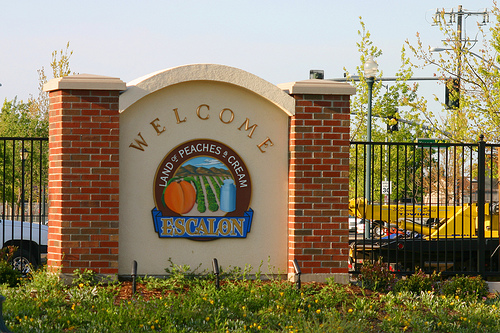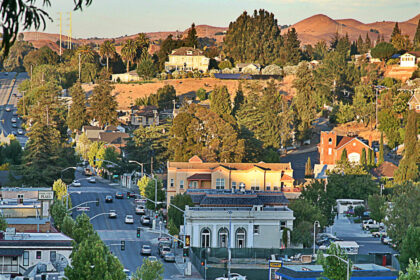Escalon is a city in San Joaquin County, California, United States. Take a look below for 20 amazing and interesting facts about Escalon, California, United States.
1. The population was 7,132 at the 2010 census, up from 5,963 at the 2000 census.
2. Escalon is a Spanish word meaning “stepping stones.”
3. The name comes from founder James Wheeler Jones who came upon the name in a book in the Stockton Free Library and liked the name so much he gave the name to the town.
4. Before the advent of the railroad, the traveler in riding over the French Camp road to the Stanislaus River would notice far out on the plains a large two-story brick house.
5. It was surrounded by trees and shrubs, barns, granaries, and was the only house for miles around. It was the home of “Johnny” Jones, who crossed the plains in 1852 and pitched his tent where Escalon now stands, the country at that time being Government land covered with sage brush.
6. He acquired the amount of land allotted to actual settlers and started to farm it, planting the first grain ever grown in the Escalon country, seeding it broadcast and dragging it in with brush. The yield was heavy and sold for five cents a pound.
7. He began raising cattle for market and purchasing more land until he possessed a small kingdom, 8,000 acres, a tract of land over three miles square. It was no unusual sight to see from six to twelve-horse teams plowing over the field where Escalon now stands.
8. In 1867 he built the brick house for his family residence at a cost of $12,000. The bricks used for it were made by his brother Richard, from a field east of Sexton station, on the Tidewater Railroad. In those days all freight carried from Stockton to the mines above Sonora went via the French Camp road, and many of the teamsters boarded and lodged at his farm.
9. The plains were the homes of many antelope, which he often served on his table.
10. Escalon is a Spanish word meaning stepping stones. What relation it has to the town is difficult to imagine. James W. Jones, the founder of the town, is said to have seen the name in a book in the Stockton Free Library and pleasing him he gave the name to the place.
11. His father died in 1893, leaving quite a fortune. He willed the old home place to James W., together with the adjoining 1,000 acres. The land at that time was not of any great value, but in the following year along came the Valley Railroad, recorded in another chapter, and the land began to increase in value.
12. As soon as Mr. Jones was assured of the railroad crossing the land he engaged a surveyor and laid off the town. The boundary lines run nearly north, south, east and west, but the streets run diagonally, thus some blocks are square, others oblong, some are rectangular and several blocks are triangular in shape.
13. John McGinnis, in recording some of the first events in Escalon says, “In the month of August, 1894, I was accosted, in Stockton, by a promoter of the townsite, Mr. Harlon, and was prevailed upon to make the trip to Escalon. The four-horse stage was brought forward by the hostler and James Jones, popularly called ‘Jim, ‘took the ribbons.
14. As soon as the town was surveyed Mr. Jones built a good sized hotel to accommodate the prospective buyers who came by stage from Stockton, which was located about where the Presbyterian Church now stands. The first Santa Fe train rolled into Escalon in the spring of 1896.
15. The post office and the first store were started by Mrs. Charles Jordan, wife of the station agent, on ground now occupied by the Tuolumne Lumber Company. The second store was built by Nelson Leighton, a large two-story building facing the railroad with a hall above used for social functions.
16. Mr. Leighton installed in his store the first telephone switchboard in Escalon. The first warehouse was built by David L. Jones and John A. Coley in 1897, and another was built later by Haslacher & Kahn, of Oakdale.
17. The first long-distance telephone was installed in John Coley’s residence ; and he was the first real estate agent and grain dealer in the town, and built many of the dwellings for rent and sale.
18. The school was first opened near the celebrated lone tree as early as 1878. It was in session only six months of the year, with an enrollment of 31 boy’s and girls, with an aver- age attendance of 15 pupils. After the. founding of Escalon the school district was divided, and a new district school started in the new town. The trustees of the new district, two of them, AV. A. Owens and J. A. Coley, succeeded in getting the people to bond the district for a small sum and the money was used in purchasing a lot about 1903 and erecting a two-room schoolhouse.
19. The first teacher, Miss Stella Reynolds, had formerly taught the Lone Tree school, with splendid success. The school has had a steady and substantial growth during the past decade and in 1914 it was found necessary to provide larger accommodations for the pupils. The citizens cheerfully voted more bonds, the present grammar school grounds were purchased and a hand- some building constructed of hollow tile.
20. The number of scholars continued to increase and last year an additional four class rooms were built’ at a cost of $18,000. The entire building was then covered with mastic. One, of the features of the additional rooms was an assembly hall seating about 400 persons which can be used as a public auditorium. Mrs. Grace Taylor Pearce has been principal for the past nine years and under her administration the school has been placed on the accredited list of the county.




